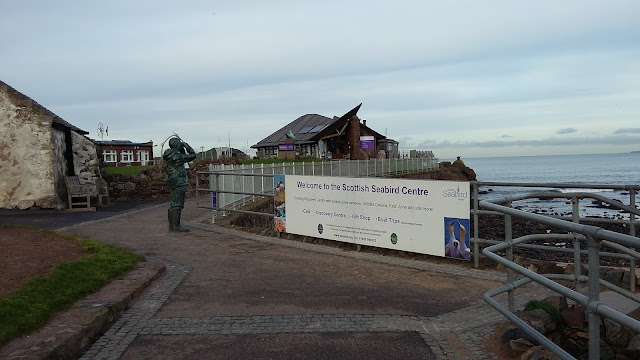Mid-week I took a trip to the Seabird Centre in North
Berwick. The last time I visited the centre I was only 15 years old and
beginning to show an interest in working with nature. My dad took the family
along and I remember chatting to the staff there and thinking “WOW! This is
what I want to do”. Needless to say it had changed significantly since then
with new displays, live feeds from the Forth islands and even a
new marine tank complete with native rocky shore animals. It was fantastic to
see the centre continuing to inspire new seabird fans just as it did all those
years ago. Interested in learning more about the Seabird Centre check out their
website including LIVE cameras from the Forth Islands: http://www.seabird.org
 |
| Hermit Crab (Pagurus bernhardus) in the marine display at Seabird Centre (photo Laura Shearer) |
During the autumn months grey seals (Halichoerus
grypus) give birth around the UK. As a marine mammal medic for the
British Divers Marine Life Rescue (BDMLR), we are called to sick or injured
seal pups which may need specialist care and rehabilitation. As a result I
joined other medics for a tour around the Scottish Society for the Protection
of Cruelty to Animals (SSPCA) wildlife centre which has a purpose built
facility for seal rehabilitation. It was excellent to see the amazing
facilities they have including isolation units, specialist veterinary rooms and
large pools to allow the seals to perform natural behaviours. This is the
largest facility of its kind in Scotland, with the potential to support up to
100 seals at one time.

 If you come across a sick or injured seal please contact the
BDMLR on 01825 765546 during office hours or 07787433412 out of office hours.
The SSPCA is a charity so check their website to learn more about how you can
support their work: https://www.scottishspca.org/
If you come across a sick or injured seal please contact the
BDMLR on 01825 765546 during office hours or 07787433412 out of office hours.
The SSPCA is a charity so check their website to learn more about how you can
support their work: https://www.scottishspca.org/ |
| Grey Seal pup (photo David Steel) |


































